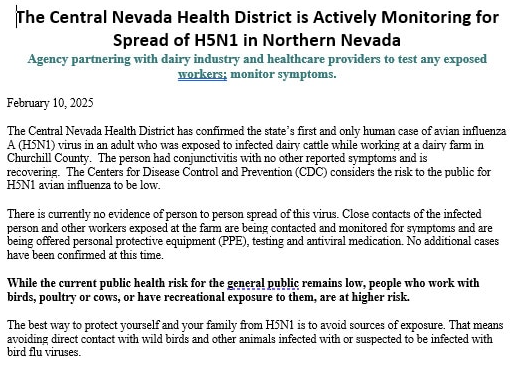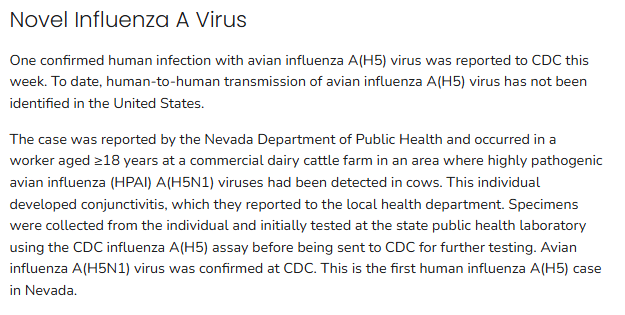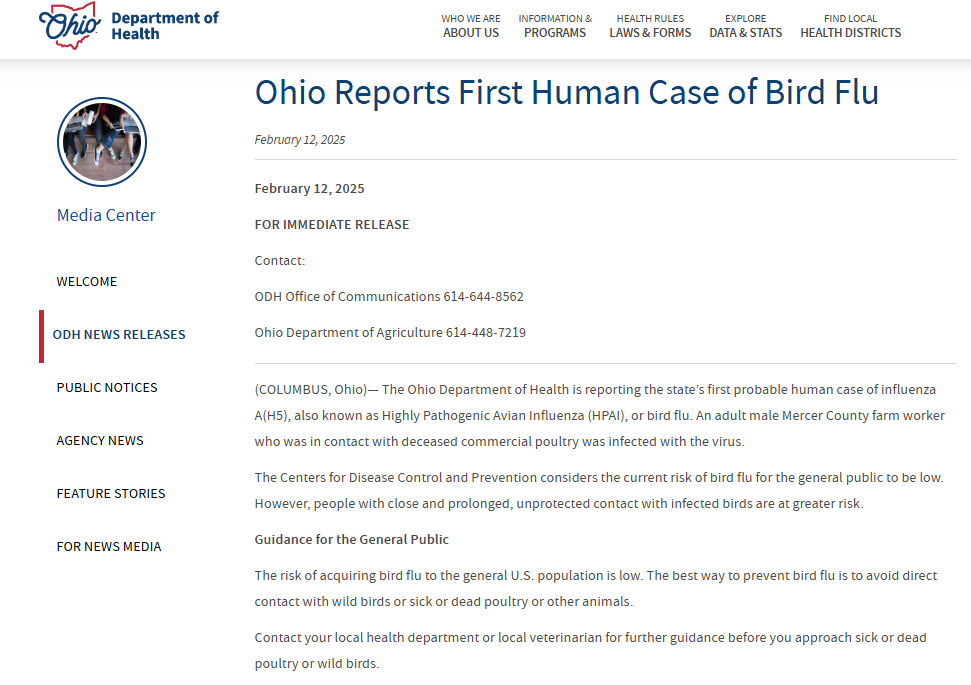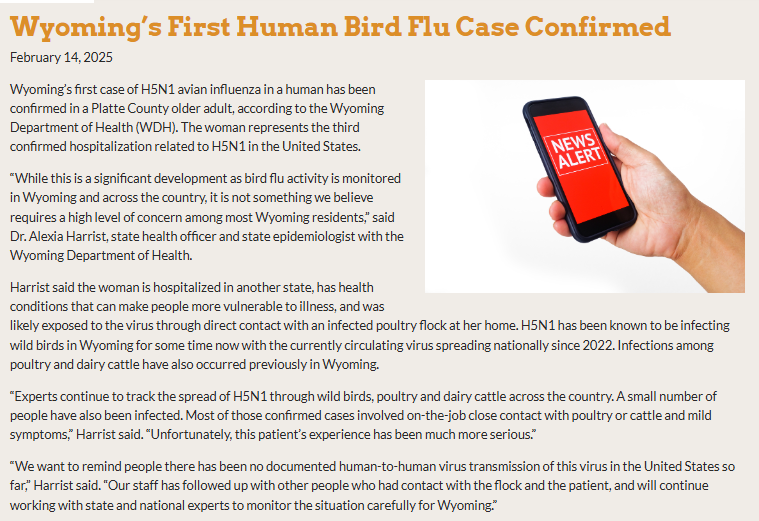This last week was busy with new human H5N1 bird flu cases in 3 states. We have the first reported case in Nevada, with exposure from dairy cattle. We have the first case from Ohio, with exposure to poultry. And we have the first case out of Wyoming, with exposure to backyard poultry and the patient being hospitalized.
Bird flu case in Nevada dairy cattle farm worker:
On Monday, February 10, Nevada health authorities confirmed the first human H5N1 case. On that same date, the USDA had reported 2 more infected dairy cattle herds in Nevada, bringing the total up to 6 herds infected with H5N1. The Nevada cattle herds are infected with genotype D1.1, which is circulating and spreading through wild migratory birds. This is a different version of the virus than what is spreading through other cattle herds.
The press release from Nevada states as follows:

Not much information is provided other than the fact that this person is an adult “who was exposed to infected dairy cattle while working at a dairy farm in Churchill County” and that the person “had conjunctivitis with no other reported symptoms and is recovering.”
Of note, Churchill County is the location that recently reported H5N1 genotype D1.1 infections in dairy herds. It is likely that this person was infected with the same genotype, although that has not been confirmed as of yet.
The CDC confirmed this new case and it is reflected on its chart of human H5N1 infections. This new case is also included on the CDC’s FluView report:

As noted in FluView, it confirms that the person worked at a commercial dairy cattle farm in a location where H5N1 had been detected in cattle. After developing conjunctivitis, the person reported to their local health department in Churchill County, Nevada.
Bird flu case in Ohio poultry farm worker:
Meanwhile, in Ohio, the state health department on February 12 reported the first probable human H5N1 case. This probable case is in a poultry worker.
The Ohio press release states as follows:

The new Ohio case is an “adult male Mercer County farm worker who was in contact with deceased commercial poultry was infected with the virus.”
Of note, Ohio has recently had a huge uptick in H5N1 infected poultry farms. The state department of agriculture’s website provides a table of identified infected poultry farms by county. Since the beginning of February, there have been 19 confirmed outbreaks on commercial poultry farms, and of those 16 have been in Mercer County, where this new human case is located.
Although just looking through the table on this website shows the extent of the ongoing outbreak in Ohio, with plenty of confirmed infections earlier this year, as well as a handful from 2024, 2023, and 2022. It invites the question of why are we just seeing a human case from this area?
Bird flu case in Wyoming:
Finally, on Friday, February 14, the first human H5N1 bird flu case was reported in Wyoming. According to the state health department, the case is in a woman from Platte County and, notably, is currently hospitalized.
The Wyoming press release on this case states as follows:

As to exposure, all we know here is that this woman was “likely exposed to the virus through direct contact with an infected poultry flock at her home.”
The press release also notes that, compared with the majority of recent human cases that have been mild, “[u]nfortunately, this patient’s experience has been much more serious.”
The fact that the statement goes on to mention that H5N1 has been “infecting wild birds in Wyoming for some time now” might indicate that this woman’s backyard flock was indeed infected by wild birds. This suggests she may be infected with genotype D1.1.
If that is the case, this is the third case of severe disease from H5N1 bird flu, all of which have been of this genotype:
- In December, a Louisiana man was infected with H5N1 genotype D1.1 from his backyard flock, causing severe disease. He was hospitalized and died in early January. This was the first known human case of H5N1 infection directly from backyard birds.
- A month earlier, in British Columbia, Canada, a teenager was infected with H5N1 genotype D1.1, which caused severe disease. After a lengthy hospitalization she survived, while the exact route of her exposure remains unknown.
Given that she is currently hospitalized this may be another instance of a more severe H5N1 human case associated with the strain circulating in birds rather than cattle.
However, and as noted above, the new human case from Wyoming may also genotype D1.1, and that case is reported to be mild. Several of the human H5N1 infections in western states have also been of this genotype with mild symptoms.
The extent of unknown mild or asymptomatic H5N1 human cases:
A related inquiry to the above involves the extent of unknown spread of this virus, through humans as well as other animals. But as to humans, while cases with known symptoms like conjunctivitis or mild respiratory symptoms have been reported, and severe cases requiring hospitalization, there is always the possibility that more human cases have gone undetected.
We know that poultry culling activities inherently carry a higher risk of exposure to bird flu. Clearly dairy farm workers are also at higher risk. We also know that many of the recent H5N1 human cases have been mild or even asymptomatic.
Indeed, the CDC just released an MMWR detailing a recent serosurvey of veterinarians who either worked with cattle or poultry to determine the extent of any previously unknown H5N1 infections. Of the 150 veterinarians involved, 3 of them had H5N1 antibodies, indicating prior H5N1 infection. Two worked with cattle and the third worked with poultry. None of them reported having any symptoms.
So it is certainly possible, if not a certainty, that human infections have been missed. What that means for the future is hard to say. It’s good that the vast majority of human cases have been mild, but there is no guarantee that this won’t change.
There really are no guarantees when it comes to influenza.
Until next time.
For more bird flu updates and research study analysis, be sure to read my other articles and follow me on social media.
Leave a comment below and join the discussion, and always feel free to reach out to me!



This post provided me with new insights on the subject, appreciate it.
I am grateful for your willingness to share your expertise with others; it’s highly appreciated.
Pingback: H5N1 genotype D1.1 in dairy cattle reported in Arizona - Bird Flu Studies
Pingback: H5N1 human case in Ohio infected with genotype D1.3 - Bird Flu Studies